Tackle Boxes
With all the gear and tackle you have or are going to buy, you will need a way to store and organize everything. This is where the tacklebox comes in. And as daunting as the number of tackle items and lures there are, which tacklebox to use can also have you scratching your head. There are many options available to store all of your tackle in one box or specialty boxes for storing specific type tackle.
If you have a lot of tackle, one box may not be enough. But carrying multiple boxes along with rods and reels can become burdensome and frustrating. Choose wisely. Below are some common tackleboxes and storage systems available along with descriptions. Take a look to see what might work for you.
Note: Some fishing boats have incorporated tackle storage systems into the deck or storage areas.
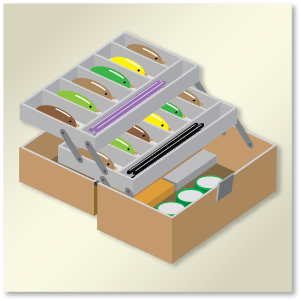 Traditional Tackle Box
Traditional Tackle Box
The Traditional Tackle Box is a typical box that most everyone is familiar with. If a fisherman doesn’t have one now, he probably had one when first starting out fishing or as a youngster. Though there are a lot of fancy and specialty boxes available, a traditional box still can’t be beaten when starting out or when a lot of tackle space isn’t needed.
The traditional box comes in many sizes to accommodate any need. There are usually two to three trays with divided compartments that fold out for storing crankbaits, hooks, sinkers, and plastic baits. A large bottom area is useful for storing line, reels, floats, pliers, and stringers. Almost any color is available including ones with your favorite cartoon characters on them.
Look for boxes that are made well and have a good latch. You may pay a little more, but for the years the box will be used, it’s worth it. Many boxes also take a lot of abuse, and a weak latch will leave you picking up your tackle from the bank or the bottom of the boat. If you outgrow the box, pass it down or find other uses for it, a good box can provide many years of good use.
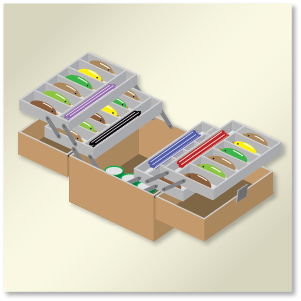 Hip Roof Box
Hip Roof Box
The Hip Roof Box is similar to the traditional tackle box, but has two sides instead of one. The hip roof box comes in many sizes and colors. Folding trays can number from two to five on each side, with enough compartments to hold one hundred lures. The largest tackle boxes come in the hip roof style.
The bottoms of these boxes are very spacious with room to store line, reels, floats, pliers, stringers, and in some cases, lunch. With some boxes, additional bottoms can be added for extra storage. The latch system on the hip roof can vary. Latches can be found on the top, sides, or on all three places.
When looking for a hip roof box, be sure to purchase well made box. Look for a box with well made trays that are worm proof (meaning that the plastic baits won’t melt into the trays). The box should have good hinges, and a good firm latch system. A cheap flimsy box will only give you aggravation. If you already have a large hip roof box, you’ll probably never need to buy another tackle box. Unless of course the box becomes too heavy or it won’t fit in the boat anymore.
If moving on to another style of tackle box, pass down the old one. If the box is huge and has been a pain to carry all these years, give it to your fishing rival, after a couple of years, he’ll look at your friendly gesture in a different way.
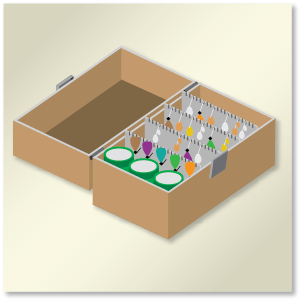 Spinnerbait Box
Spinnerbait Box
Another specialty box, the Spinnerbait box was designed for storing of course, spinnerbaits. The box has racks with grooves that work well for hanging spinnerbaits and keeping them from getting tangled. Though the box was designed for spinnerbaits, the racks work well for storing crankbaits and jigs as well.
The spinnerbait box is usually small compared to other types of tackleboxes, but can hold a good number of baits. The racks will lift out for cleaning, rearranging baits, or when looking for baits that have dropped to the bottom. When looking for a spinnerbait box, be sure to purchase a well made box that is large enough, has sturdy racks, good hinges, and a good latch system.
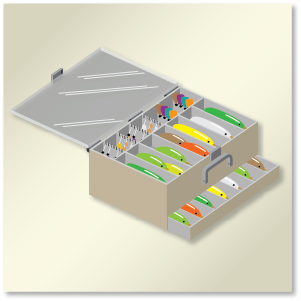 Combination Box
Combination Box
The Combination type tackle box is like having a lot of tackle boxes in one. This type of box comes in many sizes and styles, but most are about the size of a hip roof box. There is usually one large clear lid, which allows you to see the contents of the box, two or more trays that lift out, a storage area below, and racks for hanging spinnerbaits, crankbaits, and jigs.
The trays usually differ in compartment design, one for plastic baits, the others for hooks, sinkers, and crankbaits. The laydown design also keeps the box from tipping over, and a tight lid keeps the contents of the box in place. When looking for a combo box, be sure to purchase a well made box. There are many sizes and styles available. Look for a box with well made trays that lift out easily, and that are worm proof (meaning that the plastic baits won’t melt into the drawers). The box should be large enough to last for years, and the lid should have good hinges, and a good firm latch system.
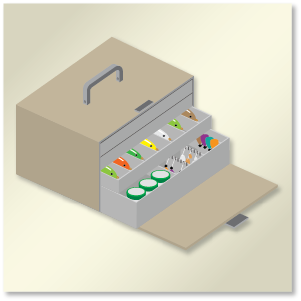 Drawer Type Box
Drawer Type Box
The Drawer type tackle box is different from other types of boxes in that instead of trays, there are drawers. The drawers, similar in construction to trays, slide out from the box instead of lifting up. The advantage to this is the number of drawers available, and the box can be stored and opened in smaller areas.
As mentioned, the drawers are similar to trays and can hold crankbaits, hooks, sinkers, and plastic worms, and can be labeled for type of baits. A large drawer at the bottom can be used to store reels, lines, floats, pliers, etc. When looking for a drawer box, be sure to purchase well made box. There are many sizes and styles available. Look for a box with well made drawers that slide easily, and that are worm proof (meaning that the plastic baits won’t melt into the drawers). The lid, which can also be used as a small worktable, should have good hinges, and a good firm latch system. A cheap flimsy box with sticking drawers will only give you aggravation.
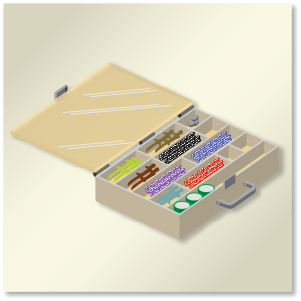 Worm Box
Worm Box
The Worm/Jig box pictured is considered a specialty box. Though this type of box can be used to hold almost any type of lure, it was designed with plastic baits and jigs in mind. This type of box is usually one or two sided. There are long trays that run the length of the box and can be sectioned off with dividers. The clear lid allows the fisherman to see where the baits are before opening the box.
As mentioned earlier, though this box is meant for worms and jigs, the dividers allow the box to be used for crankbaits, topwater baits, etc. This type of box also has compartments for storing jars of pork baits, hooks, and sinkers. Some styles have trays that lift out with additional trays underneath.
When looking for a worm/jig box, be sure to purchase a well made box. There are many sizes and styles available. Look for a box with well made trays that lift out easily, and that are worm proof so plastic baits won’t melt into the drawers. The box should be large enough to last for years, and the lid should have good hinges, and a firm latch system.
 Pouches
Pouches
A unique type of tackle storing system is the soft pouch. Made of tightly woven nylon and clear plastic, the pouch comes in many styles and sizes. One of the advantages of the pouch over tackles boxes is storage. Not just the baits, but the pouches themselves. In many cases the pouch can be stored in areas where a tackle box won’t fit. Because the pouches are flexible, they can be laid out flat or folded, and the clear plastic allows the fisherman to see the contents of each pouch without opening them. With the soft pouch storage system being available in many sizes, any type of bait can be stored in them. including plastic baits. If space is a concern, or if you want to keep your baits separated, the soft pouch system might be worth a try.
When looking for soft pouches, be sure to purchase ones that are well made, will meet your needs, and have good fastening devices.
Modular Tackle Storage
The modular tackle storage system is similar to the drawer type tackle box except that the drawers have been replaced with utility type boxes. The utility boxes are available in different configurations including customizable compartments or bays. The boxes allow lures to be grouped by type, size and color and keep the tacklebox clean and well organized. The boxes can hold crankbaits, hooks, sinkers, and plastic baits, and can be labeled for type of baits.
The utility boxes can be organized for the type of fishing done as well, loading the tacklebox with boxes for crappie for one trip, then switching to boxes for bass on your next trip. This allows for several boxes but only needing one tacklebox. When looking for a modular tackle storage system, consider the size and number of utility boxes and whether they’re stacked vertically or horizontally, which ever works best for you. Also look for a well-made modular tackle storage system with utility boxes that slide in and out easily, and that are worm proof (meaning that the plastic baits won’t melt into the drawers). The lid should have good hinges, and a good firm latch system.
Some older tacklebox box designs such as the drawer and combination types have included the ability to add utility boxes giving you a versatile tackle storage system. Fishing boats are also beginning to incorporate storage areas designed exclusively for storing utility boxes.
Tackle Bags
The tackle bag is unique in that it’s made of nylon or polyester instead of hard plastic. Lures and tackle are stored in utility type boxes that are available in different configurations including customizable compartments or bays. The boxes allow lures to be grouped by type, size and color and keep the tacklebox clean and well organized. The boxes can hold crankbaits, hooks, sinkers, and plastic baits, and can be labeled for type of baits. A tackle bag also has pockets for storing tools, maps and other tackle,
The utility boxes can be organized for the type of fishing done as well, loading the tackle bag with boxes for crappie for one trip, then switching to boxes for bass on your next trip. This allows for several boxes but only needing one tackle bag. When looking for a tackle bag, consider the size and number of utility boxes needed. Also look for well-made utility boxes that slide in and out easily, and that are worm proof (meaning that the plastic baits won’t melt into the drawers). The tackle bag should have tight stitching, well constructed zippers and clasps and secure handles and shoulder straps that are comfortable and will hold up.
For the adventurous type or anglers that want to hike to their fishing destination, some tackle bags are outfitted like a backpack with shoulder straps.
